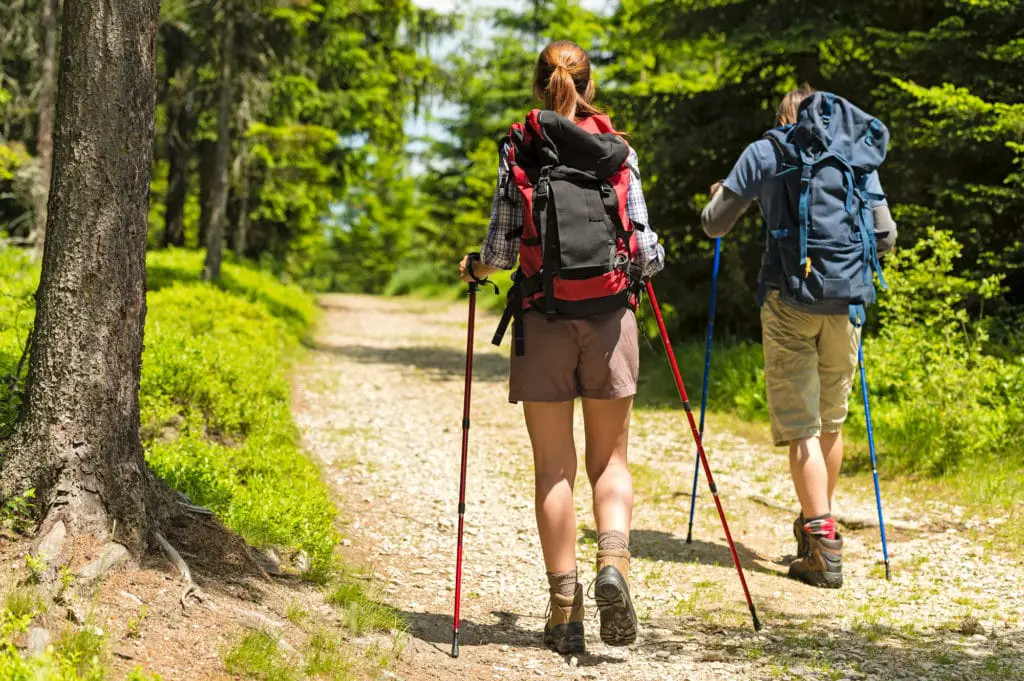Hiking is a fun and cheap way to boost your mood, experience the great outdoors and improve your cardiovascular fitness. As many experienced hikers know, hiking can take a toll on your knees because they’re carrying 90% of your body weight as you walk, making them more susceptible to injury.
The good news is that knee pain and injuries can be avoided through a combination of strength training exercises that focus on the lower body. Understanding how to strengthen the muscles surrounding your knees is crucial for hiking, especially uphill power hiking.
In this post, we share the top strengthening exercises for your lower body you should consider adding to your gym routine to ensure your knees are pain-free the next time you go on a hike.
Table of Contents
Is Hiking Bad for Your Knees?
No. hiking is good for your knees as it helps to strengthen your leg muscles. Although hiking can aggravate underlying knee issues, the main reason people suffer from knee injuries whilst hiking is that they either jump into strenuous activity too quickly after long periods of inactivity or they aren’t wearing the proper gear.
Best Exercises to Prepare Your Knees for Hiking
You are less likely to experience knee problems if you are continually strengthening your leg muscles to help support your knee function. Performing resistance exercises that work your hamstrings, glutes, and quads help support your body weight and reduce the stress placed on your knees whilst hiking.
Exercises for Uphill
Step-Ups
Step-ups are a great way to build strength in your legs, specifically your quads, hamstrings and glutes, which are the main muscle groups used in uphill hiking. The great thing about step-ups is that they can be performed with minimal equipment – you can use a dining room chair, a box or a garden step. As long as you have a sturdy base to step up on, you can do this exercise anywhere. You can set your step as high or as low as you like but be mindful that the higher the step, the more difficult the exercise will be. Step-ups focus on each leg individually, meaning you will build equal strength on both sides. This will help to improve your stability, strength and coordination for hiking uphill.
Goblet Squats
Uphill hiking requires a lot of strength and endurance. One great way of improving lower body strength is by incorporating squats into your routine. Squats target all the major muscle groups most commonly used for hiking. Goblet squats are excellent as they focus on your core muscles too.
Goblet squats are similar to front squats as you hold a weight in front of you when you squat. You can use a dumbbell, kettlebell or even a 2-litre bottle of water! Keeping the weight in front of your body at chest height also helps to strengthen your core muscles, back, forearms and, to an extent, your shoulders and upper back. This makes goblet squats a total full-body exercise.
Single-Leg Glute Bridges
The main reasons hikers develop knee issues is from the shock to their joints, not having strong glutes and hamstrings or having an imbalance where their quads are stronger than their glutes. Single leg work helps to correct any imbalances by ensuring your glutes, hamstrings and lower back is working correctly, which will protect your knees, strengthen your lower body and allow you to activate your muscles properly when hiking uphill.
Exercises for Downhill
Walking downhill puts more strain on your knees than walking uphill or on level ground. You hit the ground harder with each step and the angle does your knees no favours. To prevent knee pains when walking downhill, you should strengthen your quadricep, hamstring and calf muscles.
Wall Sits
Wall sits are a great way to build strength and endurance in the quadricep muscles at the front of your thighs. As this exercise isolates the muscles at the front of your thighs, it helps build muscular endurance which helps benefit your knees on long hikes. Wall sits involve standing against a wall with your feet shoulder width apart and bending your legs until they’re in a 90-degree angle – like a chair. The aim of this exercise is to hold the position for as long as possible while maintaining proper form. Start holding for 20 seconds and increase each round, trying to add 10 seconds each time.
Walking Lunges
Walking lunges are a great exercise to help strengthen the muscles in the leg that support the knee joint, especially the hamstrings and quads. A lunge with a long step works the hamstrings more whereas a lunge with a shorter step works the quads more. Both lunges help to strengthen the glutes.
To do a walking lunge, stand straight with your feet shoulder-width apart and core engaged. Step forward with one leg and bend your legs so that your front leg is at a right angle and your back knee is as close to the floor as possible. Repeat with the other leg as though you’re walking forward.
Other Ways to Protect Your Knees While Hiking
In addition to strength training, there are a couple of other ways to protect your knees whilst hiking including trekking poles, knee sleeves and investing in proper fitted hiking boots.
Trekking Poles

Using trekking poles whilst hiking will help to reduce knee pain as they help to give you better balance and support your knee joints whilst hiking downhill. Trekking poles help to share the load of your weight, distributing it more evenly across your body meaning they protect your knees from the impact of walking downhill.
Knee Sleeves
Compression sleeves for your knees are an excellent solution if you need to protect your knees whilst hiking as they help with improving muscle and joint stability as well as aid muscle recovery. Although not a permanent solution, knee sleeves are great for hikes when you need a little extra support. Knee sleeves should only be worn when they are needed rather than as a preventative measure.
Proper Fitting Hiking Boots
Ill-fitting footwear will take a toll on your knees and hips so it’s important to invest in a pair that have good traction, breathable materials and offer flexibility when walking. A good indicator of whether you have proper fitting hiking boots is that you can slide a finger into the boot behind your heel and you can wiggle your toes comfortably at the same time.
Take Your Time
If you suffer with knee pain when you’re hiking downhill, one of the best ways to combat it is by walking slower. While it can be tempting to walk quickly downhill, this will only put added pressure and stress on your knees. Take your time and side-step downhill to prevent stress to your joints.
Final Thoughts
Knee pain while hiking is an incredibly common issue, many hikers report some type of knee pain after hiking. But before you admit defeat, know there are things you can do to prevent it. Strength training and proper equipment are key when it comes to maintaining knee health and preventing common knee pains associated with hiking. Caring for your knees now will ensure you can hike up and down mountains for many years to come.

